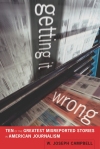A commentary today at the Huffington Post blog salutes trailblazing, rule-breaking American women–including the elusive “bra-burners” of the 1960s.
The commentary reads in part:
“From Revolutionary War icon Betsy Ross to World War II’s Rosie the Riveter, from sexually liberated 1920s femme fatale Louise Brooks to bra-burning feminists in the 1960s, from anti-slavery orator Sojourner Truth to controversial civil rights activist Angela Davis, American history is filled with female archetypes who pushed against the barriers of repression and social convention.”
True enough: History indeed counts many “female archetypes who pushed against the barriers of repression and social convention.”
But as for those “bra-burning feminists in the 1960s”–just who were they?
The commentary doesn’t say, leaving an implication that bra-burning was widespread, and even commonplace, during the 1960s.
Which just isn’t so.
 I devote a chapter to bra-burning in Getting It Wrong, my forthcoming book about media-driven myths.
I devote a chapter to bra-burning in Getting It Wrong, my forthcoming book about media-driven myths.
In that chapter, I trace the diffusion of the “bra-burning” epithet to the aftermath of the Miss America pageant at Atlantic City, N.J., on September 7, 1968.
That afternoon, about 100 women gathered on the Atlantic City boardwalk to protest the pageant as degrading to women.
A highlight of the afternoon came when demonstrators tossed into a barrel what they called “instruments of torture,” including brassieres, girdles, high-heeled shoes, and such magazines as Playboy and Cosmopolitan. The protesters dubbed the barrel the Freedom Trash Can.
The protest organizers, who included the feminist and former child actor Robin Morgan, have long insisted that the bras and other contents of the Freedom Trash Can were not set afire during the protest.
But the notion that bras had been set ablaze in flamboyant protest became a misleading legacy of that long-ago afternoon–an image promoted and spread by columnists Harriett Van Horne and Art Buchwald.
Neither of them was at the protest.
Two days afterward, Van Horne wrote in her column that there had been a bonfire in a Freedom Trash Can.
“With screams of delight,” she said of the protesters, “they consigned to the flames such shackling, demeaning items as girdles, bras, high-heeled slippers, hair curlers and false eyelashes.”
As I write in Getting It Wrong, this highly imaginative characterization was taken up a few days later by Art Buchwald in his nationally syndicated column.
Buchwald, who by then was American journalism’s leading humor columnist, wrote with tongue in cheek that he had been “flabbergasted to read that about 100 women had picketed the Miss America pageant in Atlantic City against ‘ludicrous beauty standards that had enslaved the American woman.’”
He also wrote:
“The final and most tragic part of the protest took place when several of the women publicly burned their brassieres.”
And he closed the column by writing:
“If the women in Atlantic City wanted to picket the Miss America beauty pageant because it is lily-white, that is one thing, and if they wanted to picket because it is a bore, that is also a legitimate excuse. But when they start asking young American women to burn their brassieres and throw away their false eyelashes, then we say dissent in this country has gone too far.”
And an embryonic media-driven myth had begun to emerge.
Recent and related:
- ‘Doctrinaire feminist in the bra-burning mold’?
- Behind the ‘nuanced myth’: Bra-burning at Atlantic City
- On columnists and burning bras
- The editor and the protest: Bra-burning’s intriguing sidebar
- Palin’s new book invokes ‘bra-burning’ stereotype

[…] Bra-burning in fact was a dramatically overstated phenomenon, as I discuss in a chapter in Getting It Wrong, my forthcoming book about media-driven myths–well-known and often-told stories about the news media that are dubious, apocryphal, or wildly exaggerated. […]
[…] ‘Bra-burning feminists’: Who were they? […]
[…] discuss in Getting It Wrong–which debunks 10 prominent media-driven myths–the notion of bra-burning stems from the women’s liberation protest at Atlantic City on September 7, 1968. About 100 or […]
[…] most, women’s liberation demonstrators at Atlantic City in September 1968, briefly set bras and other items afire, an episode that may […]
[…] ‘Bra-burning feminists’: Who were they? […]
[…] the fact that the bra-burning story is apocryphal, I was surprised by her answer. Is that what feminism meant to this smart […]
[…] incidents of the 60s which seems to be the result of someone’s overworked imagination, nothing but a myth perpetrated over the years (click here to read what snopes.com has to say). A cousin of mine took […]
[…] on the Atlantic City boardwalk in 1968 to become shorthand for denigrating the emergent feminist movement and dismissing it as trivial and even a bit odd. The widely misreported pandemic of ‘crack […]
[…] to ridicule feminists and dismiss their objectives as trivial and insignificant. As such, “bra-burning” underscores the potential of media myths to feed and promote […]
Why do so few American women identify themselves as feminists?…
I’d like to point out that bra burning is a myth. There were no “angry bra-burners”. It’s an absolute myth [1,2,3]. “…That’s why bra burning became the most durable and unsettling image of modern feminism. So it may be worth noting that it never…
[…] Getting It Wrong, there is compelling evidence that bras were indeed set afire, briefly, during a women’s liberation protest on the boardwalk at Atlantic […]